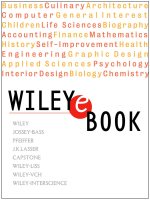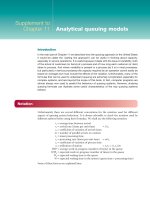Operations management 12th stevenson ch14 JIT and lean operations
Bạn đang xem bản rút gọn của tài liệu. Xem và tải ngay bản đầy đủ của tài liệu tại đây (1.21 MB, 40 trang )
Chapter 14
JIT and Lean
Operations
McGraw-Hill/Irwin
Copyright © 2012 by The McGraw-Hill Companies, Inc. All rights reserved.
Chapter 14: Learning Objectives
You should be able to:
1. Explain what is meant by the term lean operations system
2. List each of the goals of a lean system and explain its
importance
3. List and briefly describe the building blocks of lean
4. List the benefits of a lean system
5. Outline the considerations important in converting a
traditional mode of operations to a lean system
6. Point out some of the obstacles that might be
encountered when converting to a lean system
7. Describe value stream mapping
Instructor Slides
14-2
Lean Operations
Lean operation
A flexible system of operation that uses
considerably less resources than a traditional
system
Tend to achieve
Greater productivity
Lower costs
Shorter cycle times
Higher quality
Instructor Slides
14-3
Lean: Ultimate Goal
The ultimate goal:
Achieve a system that matches supply to
customer demand; supply is synchronized to
meet customer demand in a smooth
uninterrupted flow
A balanced system
One that achieves a smooth, rapid flow of materials
and/or work through the system
Instructor Slides
14-4
Goals and building blocks
of lean systems
Instructor Slides
14-5
Lean: Supporting Goals
The degree to which lean’s ultimate goal is
achieved depends upon how well its
supporting goals are achieved:
1. Eliminate disruptions
2. Make the system flexible
3. Eliminate waste, especially excess inventory
Instructor Slides
14-6
Waste
Waste
Represents unproductive resources
Seven sources of waste in lean systems:
1.
2.
3.
4.
5.
6.
7.
Inventory
Overproduction
Waiting time
Unnecessary transporting
Processing waste
Inefficient work methods
Product defects
Instructor Slides
14-7
Lean: Building Blocks
Product design
Process design
Personnel/organizational elements
Manufacturing planning and control
Instructor Slides
14-8
Building Blocks: Product Design
Four elements of product design important
for lean systems:
1. Standard parts
2. Modular design
3. Highly capable systems with quality built in
4. Concurrent engineering
Instructor Slides
14-9
Building Blocks: Process Design
Seven aspects of process design that are
important for lean systems:
1.
2.
3.
4.
5.
6.
7.
8.
Small lot sizes
Setup time reduction
Manufacturing cells
Quality improvement
Production flexibility
A balanced system
Little inventory storage
Fail-safe methods
Instructor Slides
14-10
Process Design: Small Lot Sizes
In the lean philosophy, the ideal lot size is one
Benefits of small lot size
Reduced in-process inventory
Lower carrying costs
Less storage space is necessary
Inspection and rework costs are less when problems with
quality do occur
Permits greater flexibility in scheduling
Less inventory to ‘work off’ before implementing product
improvements
Increased visibility of problems
Increased ease of balancing operations
Instructor Slides
14-11
Process Design: Setup Time
Reduction
Small lot sizes and changing product mixes require
frequent setups
Unless these are quick and relatively inexpensive,
they can be prohibitive
Setup time reduction requires deliberate
improvement efforts
Single-minute exchange of die (SMED)
A system for reducing changeover time
Group technology may be used to reduce setup time by
capitalizing on similarities in recurring operations
Instructor Slides
14-12
Process Design: Manufacturing Cells
One characteristic of lean production
systems is multiple manufacturing cells
Benefits include
Reduced changeover times
High equipment utilization
Ease of cross-training workers
Instructor Slides
14-13
Process Design: Quality
Improvement
Quality defects during the process can
disrupt the orderly flow of work
Autonomation (jidoka)
Automatic detection of defects during
production
Two mechanisms are employed
1.
2.
Instructor Slides
One for detecting defects when they occur
Another for stopping production to correct the cause
of the defects
14-14
Process Design: Work Flexibility
Guidelines for increasing flexibility
1. Reduce downtime due to changeovers by reducing
2.
3.
4.
5.
6.
changeover time
Use preventive maintenance on key equipment to reduce
breakdowns and downtime
Cross-train workers so they can help when bottlenecks occur
or other workers are absent
Use many small units of capacity; many small cells make it
easier to shift capacity temporarily and to add or subtract
capacity
Use off-line buffers. Store infrequently used safety stock away
from the production area
Reserve capacity for important customers
Instructor Slides
14-15
Process Design: Balanced System
Takt time
The cycle time needed to match customer demand for
final product
Sometimes referred to as the heartbeat of a lean system
Takt time is often set for a work shift
Procedure:
1.
2.
3.
Instructor Slides
Determine the net time available per shift
If there is more than one shift per day, multiply the
net time by the number of shifts
Compute the takt time by dividing the net available
time by demand
14-16
Process Design: Inventory Storage
Lean systems are designed to minimize
inventory storage
Inventories are buffers that tend to cover up recurring
problems that are never resolved
partly because they are not obvious
partly because the presence of inventory makes them
seem less serious
Instructor Slides
14-17
Process Design: Fail-Safe Methods
Poka-yoke (Fail Safing)
Building safeguards into a process to reduce or
eliminate the potential for errors during a
process
Examples
Electric breakers
Seatbelt fastener warnings
ATMs that signal if a card is let in a machine
Designing parts that can only be assembled in the
correct position
Instructor Slides
14-18
Building Blocks:
Personnel/Organizational
Five personnel/organizational elements
that are important for lean systems:
Workers as assets
Cross-trained workers
Continuous improvement
Cost accounting
Leadership/project management
Instructor Slides
14-19
Personnel/Organizational:
Workers as Assets
Workers as assets
Well-trained and motivated workers are the
heart of the lean system
They are given greater authority to make
decisions, but more is expected of them
Instructor Slides
14-20
Personnel/Organizational:
Cross-Trained Workers
Cross-trained workers
Workers are trained to perform several parts of
a process and operate a variety of machines
Facilitates flexibility
Helps in line balancing
Instructor Slides
14-21
Personnel/Organizational:
Continuous Improvement
Continuous improvement
Workers in lean systems have greater
responsibility for quality, and they are
expected to be involved in problem solving
and continuous improvement
Lean workers receive training in
Statistical process control
Quality improvement
Problem solving
Instructor Slides
14-22
Personnel/Organizational:
Cost Accounting
Cost accounting
Activity-based costing
Allocation of overhead to specific jobs based on
their percentage of activities
Instructor Slides
14-23
Personnel/Organizational:
Leadership
Leadership/project management
Managers are expected to be leaders and
facilitators, not order givers
Lean systems encourage two-way
communication between workers and managers
Instructor Slides
14-24
Building Blocks: MPC
Seven elements of manufacturing planning
and control (MPC) are particularly
important for lean system:
1.
2.
3.
4.
5.
6.
7.
Level loading
Pull systems
Visual systems
Limited work-in-process (WIP)
Close vendor relationships
Reduced transaction processing
Preventive maintenance and housekeeping
Instructor Slides
14-25









